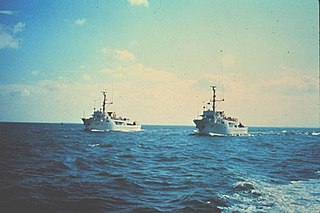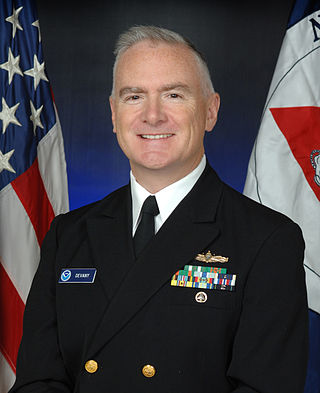
The National Oceanic and Atmospheric Administration Commissioned Officer Corps is one of eight federal uniformed services of the United States, and operates under the National Oceanic and Atmospheric Administration (NOAA), a scientific agency overseen by the Department of Commerce. The NOAA Corps is made up of scientifically and technically trained officers. The NOAA Corps and the United States Public Health Service Commissioned Corps are the only U.S. uniformed services that consist only of commissioned officers, with no enlisted or warrant officer ranks. The NOAA Corps' primary mission is to monitor oceanic conditions, support major waterways, and monitor atmospheric conditions.

The Office of Marine and Aviation Operations (OMAO) is a division of the National Oceanic and Atmospheric Administration (NOAA) which operates a wide variety of specialized ships and aircraft to carry out the environmental and scientific missions of NOAA.

NOAAS Rude was an American Rude-class hydrographic survey ship that was in commission in the National Oceanic and Atmospheric Administration (NOAA) from 1970 to 2008. Prior to her NOAA career, she was in commission in the United States Coast and Geodetic Survey from 1967 to 1970 as USC&GS Rude. She was named for Gilbert T. Rude, former Chief of the Division of Coastal Surveys of the Coast and Geodetic Survey.

NOAA Ship Rainier is a survey vessel in commission with the National Oceanic and Atmospheric Administration (NOAA). Her primary mission is to chart all aspects of the ocean and sea floor, primarily in Alaska and the Pacific Northwest. The ship is home-ported at the NOAA Marine Operations Center–Pacific in Newport, Oregon.

The Environmental Science Services Administration (ESSA) was a United States Federal executive agency created in 1965 as part of a reorganization of the United States Department of Commerce. Its mission was to unify and oversee the meteorological, climatological, hydrographic, and geodetic operations of the United States. It operated until 1970, when it was replaced by the new National Oceanic and Atmospheric Administration (NOAA).

Richard R. Behn, is a retired one-star rear admiral of the National Oceanic and Atmospheric Administration Commissioned Officer Corps who served as director of the National Oceanic and Atmospheric Administration's Marine and Aviation Operations Centers, from August 2004 to September 2007. He was nominated for this position by President George W. Bush, confirmed by the Senate, and subsequently promoted to rear admiral in August 2004.

Evelyn J. Fields is a rear admiral, retired, of the National Oceanic and Atmospheric Administration Commissioned Officer Corps, who served as the director of the Commissioned Officer Corps and director of NOAA's Office of Marine and Aviation Operations, from 1999 until her retirement in 2003. Fields was the first woman, and first African American to head the NOAA Corps.

The United States Coast and Geodetic Survey was the first scientific agency of the United States Government. It existed from 1807 to 1970, and throughout its history was responsible for mapping and charting the coast of the United States, and later the coasts of U.S. territories. In 1871, it gained the additional responsibility of surveying the interior of the United States and geodesy became a more important part of its work, leading to it being renamed the U.S. Coast and Geodetic Survey in 1878.

Philip M. Kenul is a retired NOAA Corps rear admiral who last served as the Director, NOAA Marine and Aviation Operations Centers, which are part of National Oceanic and Atmospheric Administration’s Office of Marine and Aviation Operations (OMAO). As director, Kenul was responsible for the operation of NOAA aircraft and ships as well as the management of OMAO’s operations centers’ $100M budget and more than 500 fleet personnel. Kenul retired from the NOAA Corps after over 30 years of service.

NOAAS Heck was a Rude-class hydrographic survey ship in the National Oceanic and Atmospheric Administration (NOAA) from 1970 to 1995. Prior to her NOAA service, she was in commission from 1967 to 1970 in the United States Coast and Geodetic Survey as USC&GS Heck.

Michael S. Devany is a former vice admiral in the NOAA Commissioned Officer Corps who last served as the deputy under secretary for operations at the National Oceanic and Atmospheric Administration from January 2, 2014 to April 2016. He previously served as director of the NOAA Commissioned Officer Corps from August 13, 2012 to January 1, 2014, succeeding RADM Jonathan W. Bailey. As deputy under secretary for operations, he was NOAA’s chief operating officer. VADM Devany was responsible for the day-to-day management of NOAA’s national and international operations for oceanic and atmospheric services, research, and coastal and marine stewardship. He is a key advisor to the under secretary of commerce for oceans and atmosphere/NOAA administrator on NOAA program and policy issues. Devany was the first NOAA Corps officer to achieve the rank of vice admiral since VADM Henry A. Karo in 1965, and the second NOAA Corps officer overall. Devany retired from NOAA in April 2016 after over 30 years of combined uniformed service.

Gerd F. Glang is a former NOAA Corps rear admiral who last served as the director of the National Oceanic and Atmospheric Administration's Office of Coast Survey. In this position, he also concurrently served as the U.S. National Hydrographer and as one of the commissioners of the Mississippi River Commission. He was appointed by Acting Secretary of Commerce Rebecca Blank on August 13, 2012, after nomination by President Barack Obama, and confirmation by the U.S. Senate. He retired from the NOAA Corps on August 26, 2016 after over 32 years of combined uniformed service.

NOAAS Whiting, was an American survey ship that was in commission in the National Oceanic and Atmospheric Administration (NOAA) from 1970 to 2003. Previously, she had been in commission in the United States Coast and Geodetic Survey from 1963 to 1970 as USC&GS Whiting.

NOAAS Ferrel was an American hydrographic survey ship that was in commission in the National Oceanic and Atmospheric Administration (NOAA) from 1970 to 2002. Prior to her NOAA career, she was in commission in the United States Coast and Geodetic Survey from 1968 to 1970 as USC&GS Ferrel.

Rear Admiral Leo Otis Colbert was the third director of the United States Coast and Geodetic Survey and a career officer in the United States Coast and Geodetic Survey Corps, predecessor of the National Oceanic and Atmospheric Administration Commissioned Officer Corps.

Rear Admiral Harley Dean Nygren was an American military officer who served in the United States Coast and Geodetic Survey Corps, its successor, the Environmental Science Services Administration Corps, and the ESSA Corps's successor, the National Oceanic and Atmospheric Administration Commissioned Officer Corps. He served as the first Director of the NOAA Corps.

Rear Admiral Francis D. "Bill" Moran is a retired career officer who served in the United States Coast and Geodetic Survey Corps, its successor, the Environmental Science Services Administration Corps, and the ESSA Corps's successor, the National Oceanic and Atmospheric Administration Commissioned Officer Corps. He served as the third Director of the NOAA Corps.

Rear Admiral Sigmund R. Petersen is a retired career officer who served in the United States Coast and Geodetic Survey Corps, its successor, the Environmental Science Services Administration Corps, and the ESSA Corps's successor, the National Oceanic and Atmospheric Administration Commissioned Officer Corps. He served as the fourth Director of the NOAA Corps.

Captain Nicholas Hunter Heck was a career officer of the United States Coast and Geodetic Survey Corps. A leading geophysicist of his time, Heck made important contributions in the study of seismology and oceanography. He also revolutionized hydrographic surveying by developing the wire-drag surveying technique and introduced radio acoustic ranging into Coast and Geodetic Survey hydrography.

Richard Thomas Brennan, Jr. was a rear admiral in the NOAA Commissioned Officer Corps where he served as the 31st director of the Office of Coast Survey, replacing Shepard Smith. He also commanded NOAA Ship Rainier and NOAA Ship Rude.
















